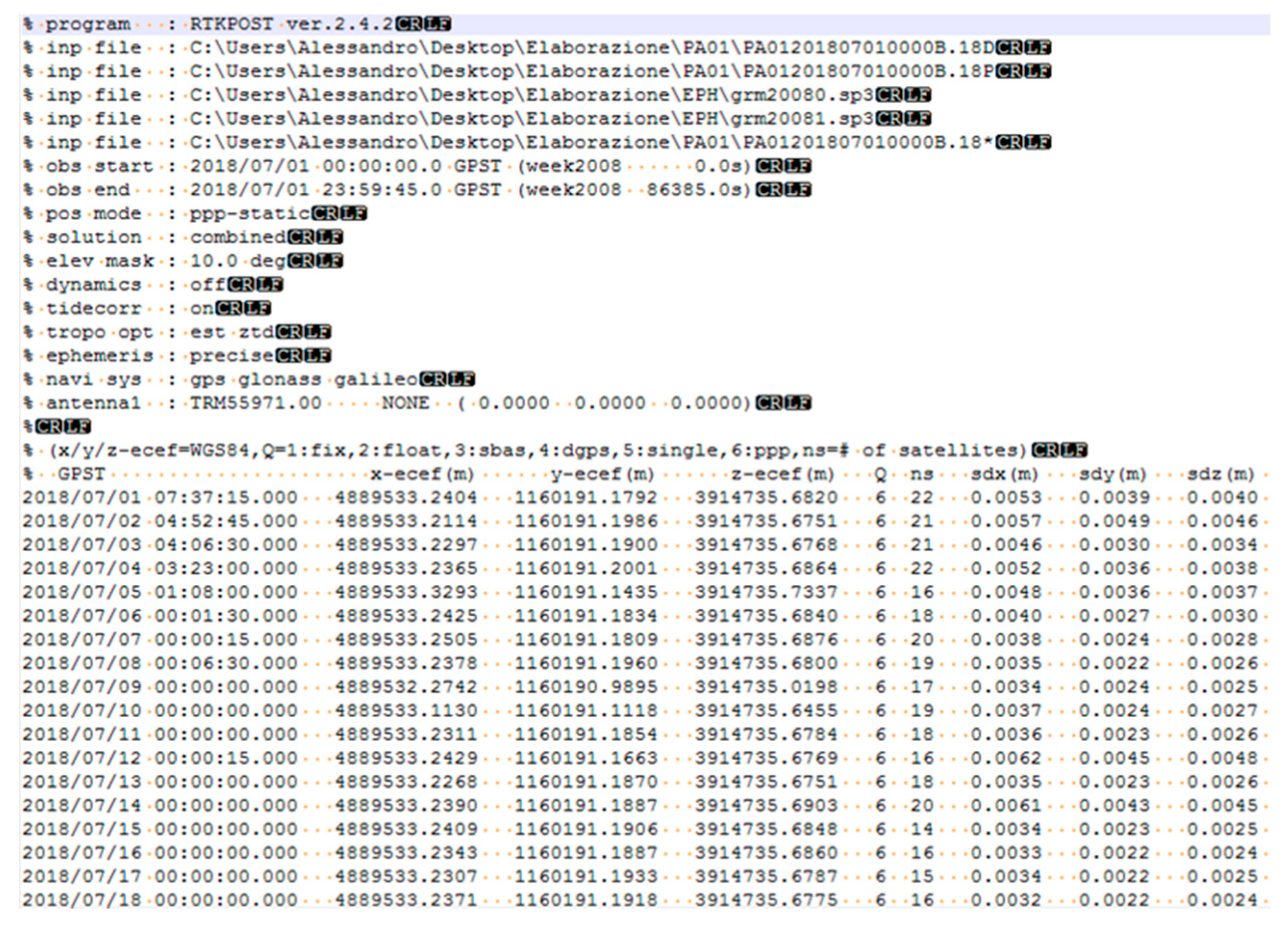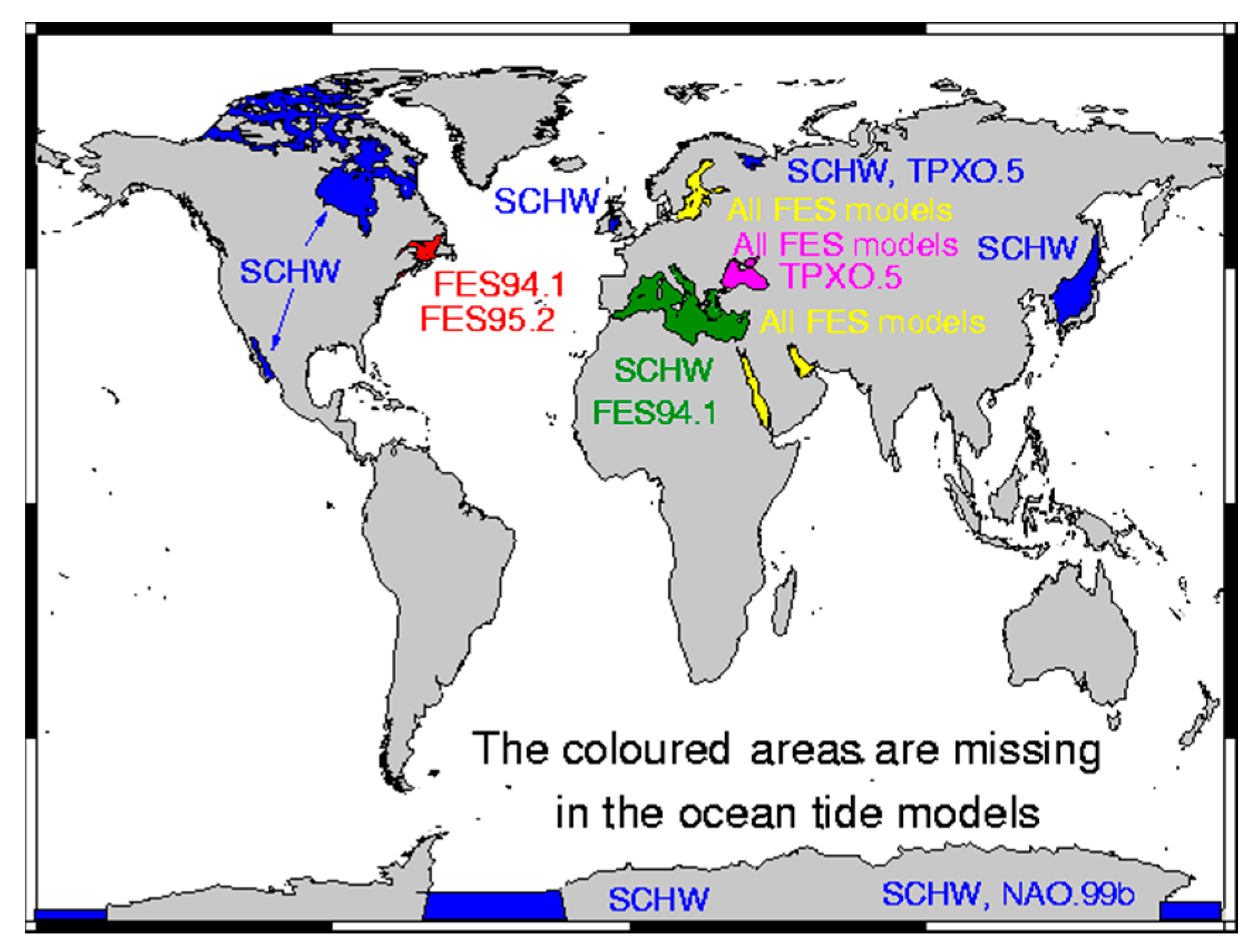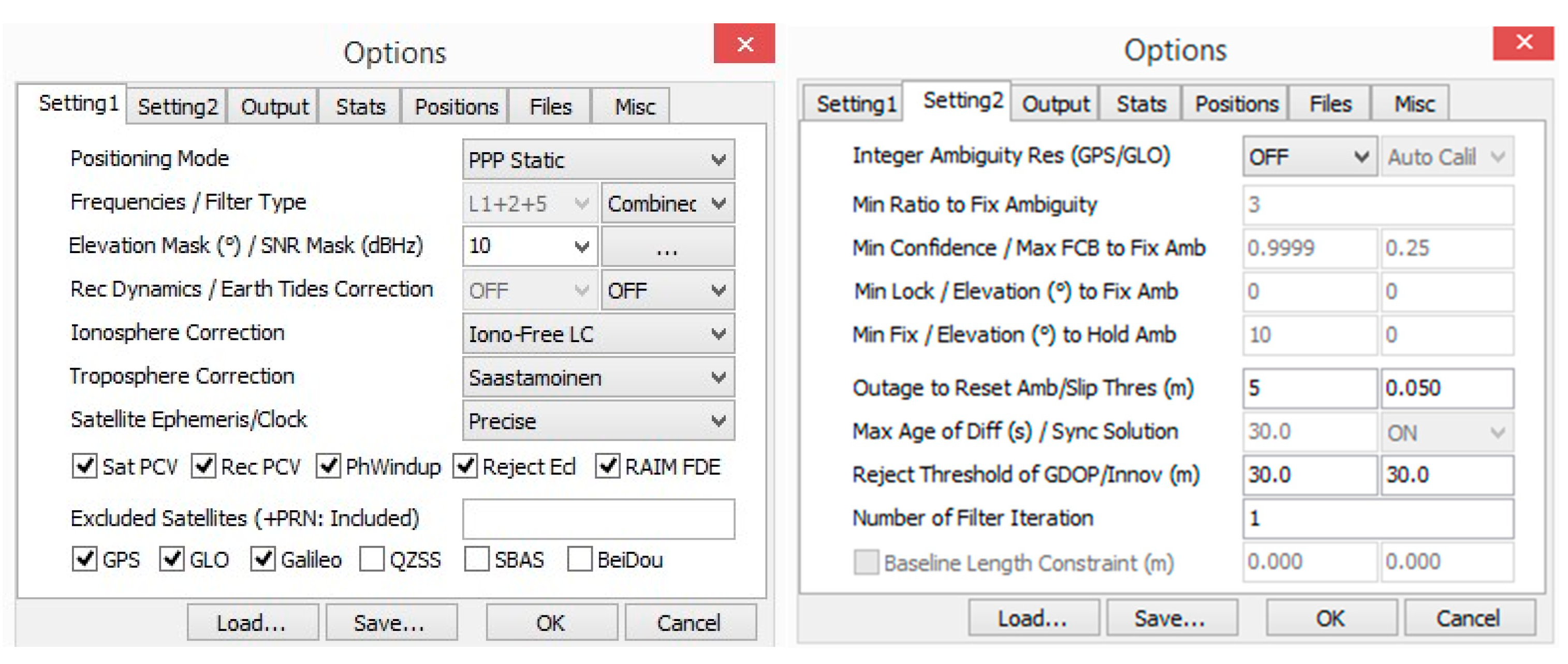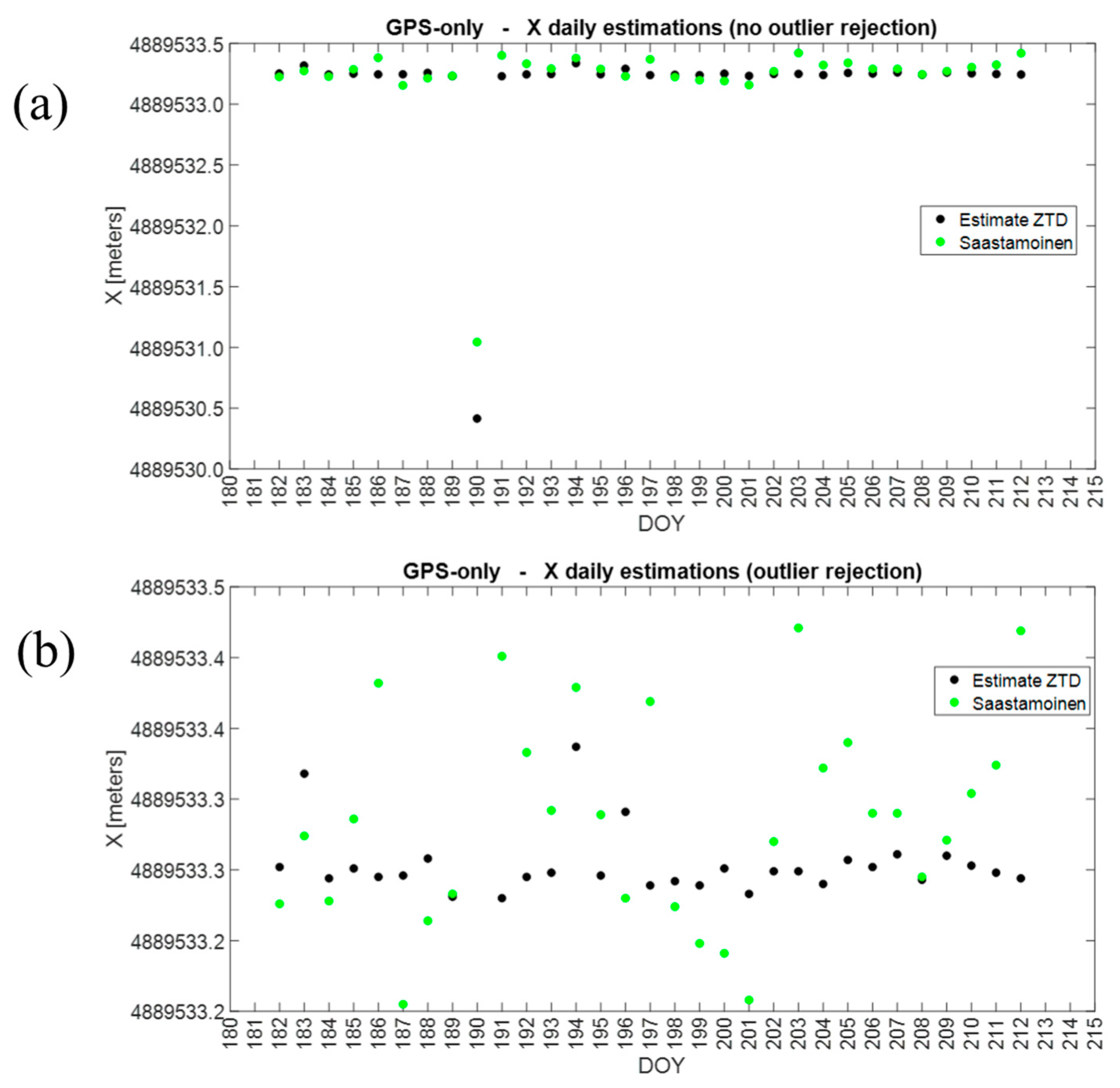Performance Assessment of PPP Surveys with Open Source Software Using the GNSS GPS–GLONASS–Galileo Constellations
Abstract
Featured Application
Abstract
1. Introduction
2. Materials and Methods
2.1. Experiment: Datasets and Location
2.2. RTKLib Software
- Phwindup (phase wind-up), to correct the delay caused by the relative rotation between the satellite and receiver antennas;
- Reject Ecl, to exclude the GPS Block IIA satellites in eclipsed, that degrade the PPP solutions due to unpredicted behavior of yaw-attitude;
- RAIM (receiver autonomous integrity monitoring) FDE (fault detection and exclusion) to detect and exclude possible outliers from the measurements set used for the solution computation;
- Sat PCV e Rec PVC, to consider the phase center variations of the satellite and the receiver, respectively, feature allowed by uploading the “igs14.atx” file, provided by the IGS, containing the correction parameters of several types of antenna;
- a GDOP threshold is set to reject solution with GDOP value higher than 30, and a mask-angle equal to 10° is applied;
- no ambiguity resolution strategy is used;
- DCB multi-GNSS product, provided by the German aerospace center DLR, in “.bsz” format, is also used as an input (Figure 6).
- to verify and compare the impact of two tropospheric correction models (Saastamoinen and Estimate ZTD);
- to evaluate the performance of PPP-static mode in terms of precision, accuracy and availability, using multi-GNSS data collected during two tests.
2.3. Comparison between Saastamoinen and Estimate ZTD Tropospheric Correction Models
- p, is the total pressure (hPa);
- T, is the absolute temperature (K) of the air;
- e, is the partial pressure (hPa) of water vapor;
- z, is the zenith angle (rad).
3. Results and Discussion
3.1. Preliminary Analyses (Test A)
3.2. Performance of Multi-GNSS Static PPP Survey with Saastamoinen and Estimate ZTD Tropospheric Models (Test A)
- the stabilities of single GNSS combinations are similar, with slightly best performance for GLONASS-only case;
- the stabilities of double GNSS combinations are increased with respect to the single GNSS case, the best performances are obtained with GPS+Galileo constellations, and the worst performances are obtained with GLONASS+Galileo;
- the stability of the triple GNSS combination is similar to double constellations cases.
3.3. Performance of Multi-GNSS Static PPP Survey with CNES/CLS (Test A)
3.4. Performance of Multi-GNSS Static PPP Survey (Test B)
4. Conclusions
- A dataset of GNSS measurements, stored at a permanent station, acquiring 24 h a day for 1 month (Test A)
- A dataset of GNSS measurements, stored by a geodetic receiver on a pillar, acquiring about 6 h a day for 10 days (Test B)
Author Contributions
Funding
Conflicts of Interest
References
- Gao, Y.; Wang, M. Precise point positioning for deformation monitoring using post-mission and real-time precise orbit and clock products. Geophys. Res. Abstr. 2007, 9, 03155. [Google Scholar]
- Wang, G.Q. Millimeter-accuracy GPS landslide monitoring using Precise Point Positioning with Single Receiver Phase Ambiguity (PPP-SRPA) resolution: A case study in Puerto Rico. J. Geod. Sci. 2013, 3, 22–31. [Google Scholar] [CrossRef]
- Capilla, R.M.; Berné, J.L.; Martín, A.; Rodrigo, R. Simulation case study of deformations and landslides using real-time GNSS precise point positioning technique. Geomat. Nat. Hazards Risk 2016, 7, 1–18. [Google Scholar] [CrossRef]
- Bisnath, S.; Gao, Y. Current State of Precise Point Positioning and Future Prospects and Limitations. Int. Assoc. Geod. Symp. 2009, 133, 615–623. [Google Scholar]
- Geng, J.; Teferle, F.N.; Meng, X.; Dodson, A.H. Kinematic precise point positioning at remote marine platforms. GPS Solut. 2010, 14, 343–350. [Google Scholar] [CrossRef]
- Tegedor, J.; Øvstedal, O.; Vigen, E. Precise orbit determination and point positioning using GPS, GLONASS, Galileo and BeiDou. J. Geod. Sci. 2014, 4, 65–73. [Google Scholar] [CrossRef]
- Innac, A.; Angrisano, A.; Gaglione, S.; Crocetto, N. GPS precise positioning techniques for remote marine applications. In Proceedings of the 2019 IMEKO TC19 International Workshop on Metrology for the Sea, Genova, Italy, 3–5 October 2019; IMEKO-International Measurement Federation Secretariat: Budapest, Hungary, 2020; pp. 81–85. [Google Scholar]
- Melgard, T.; Vigen, E.; De Jong, K.; Lapucha, D.; Visser, H.; Ørpen, O. G2—The first real-time GPS and GLONASS Precise orbit and clock service. In Proceedings of the 22nd International Technical Meeting of the Satellite Division of the ION, Savannah, GA, USA, September 22–25 2009; pp. 1885–1891. [Google Scholar]
- Cai, C.; Gao, Y. Precise point positioning using combined GPS and GLONASS observations. J. Glob. Position. Syst. 2007, 6, 13–22. [Google Scholar] [CrossRef]
- Cai, C.; Gao, Y. Modeling and assessment of combined GPS/GLONASS precise point positioning. GPS Solut. 2013, 17, 223–236. [Google Scholar] [CrossRef]
- Li, X.; Zhang, X.; Ren, X.; Fritsche, M.; Wickert, J.; Schuh, H. Precise positioning with current multi-constellation Global Navigation Satellite System: GPS, GLONASS, Galileo and BeiDou. Sci. Rep. 2014, 5, 8328. [Google Scholar] [CrossRef]
- Afifi, A.; El-Rabbany, A. An innovative dual frequency PPP model for combined GPS/Galileo observations. J. Appl. Geod. 2015, 9, 27–34. [Google Scholar] [CrossRef]
- Afifi, A.; El-Rabbany, A. Precise Point Positioning Using Triple GNSS Constellations in Various Modes. J. Appl. Geod. 2016, 10, 779. [Google Scholar] [CrossRef] [PubMed]
- Guo, F.; Li, X.; Zhang, X.; Wang, J. The contribution of Multi-GNSS Experiment (MGEX) to precise point positioning. Adv. Space Res. 2015, 59, 2714–2725. [Google Scholar] [CrossRef]
- Zhang, X.; Liu, J.; Forsberg, R. Application of precise point positioning in airborne survey. Geomat. Inf. Sci. Wuhan Univ. 2006, 31, 19–22. (In Chinese) [Google Scholar]
- Cai, C.; Gao, Y.; Pan, L.; Zhu, J. Precise point positioning with quad-constellations: GPS, Beidou, GLONASS and Galileo. Adv. Space Res. 2015, 56, 133–143. [Google Scholar] [CrossRef]
- Pandey, D.; Dwivedi, R.; Dikshit, O.; Singh, A.K. GPS and glonass combined static precise point positioning (PPP). Int. Arch. Photogramm. Remote Sens. Spat. Inf. Sci. 2016, 41, 483–488. [Google Scholar] [CrossRef]
- Angrisano, A.; Gaglione, S.; Gioia, C. Performance assessment of GPS/GLONASS single point positioning in an urban environment. Acta Geod. Geophys. 2013, 48, 149–161. [Google Scholar] [CrossRef]
- Guo, J.; Li, X.; Chen, X.; Geng, J.; Wen, Q.; Pan, Y. Performance Analysis of Multi-GNSS Precise Point Positioning. In China Satellite Navigation Conference; Springer: Singapore, 2017. [Google Scholar]
- Abd Rabbou, M.; El-Rabbany, A. Performance analysis of precise point positioning using multi-constellation GNSS: GPS, GLONASS, Galileo and BeiDou. Surv. Rev. 2017, 49, 39–50. [Google Scholar] [CrossRef]
- El Manaily, E.; Adb Rabbou, M.; El-Shazly, A.; Baraka, M. Evaluation of quad-constellation GNSS precise point positioning in Egypt. Artif. Satel. 2017, 52, 9–18. [Google Scholar] [CrossRef]
- Pan, L.; Zhang, X.; Li, X.; Li, X.; Lu, C.J.; Liu, J.; Wang, Q. Satellite availability and point positioning accuracy evalutation on a global scale for integration of GPS, GLONASS, BeiDou and Galileo. Adv. Space Res. 2019, 63, 2696–2710. [Google Scholar] [CrossRef]
- Van Bree, R.J.P.; Tiberius, C.C.J.M. Real-time single-frequency precise point positioning: Accuracy assessment. GPS Solut. 2012, 16, 259–266. [Google Scholar] [CrossRef]
- Innac, A.; Gaglione, S.; Angrisano, A. Multi-GNSS Single Frequency Precise Point Positioning. In Proceedings of the 2018 IEEE International Workshop on Metrology for the Sea; Learning to Measure Sea Health Parameters (MetroSea), Bari, Italy, 8–10 October 2018. [Google Scholar]
- Innac, A.; Angrisano, A.; Gaglione, S.; Vultaggio, M.; Crocetto, N. Performance Comparison among Multi-GNSS Single Frequency Precise Point Positioning Techniques. Kartografija i geoinformacije (Cartogr. Geoinf.) 2019, 18, 80–99. [Google Scholar] [CrossRef]
- Zrinjski, M.; Barković, Ð.; Matika, K. Development and modernization of GNSS [Razvoj i modernizacija GNSS-a]. Geod. List 2019, 73, 45–65. [Google Scholar]
- Abd Rabbou, A.M.; El-Shazly, A.; Ahmed, K. Comparative analysis of multi-constellation GNSS single-frequency precise point positioning. Surv. Rev. 2017, 50, 373–382. [Google Scholar] [CrossRef]
- Dardanelli, G.; Lo Brutto, M.; Pipitone, C. GNSS CORS Network of the University of Palermo: Design and first analysis of data. Geogr. Tech. 2020, 15, 43–69. [Google Scholar] [CrossRef]
- Dardanelli, G.; Carella, M. Integrated surveying with mobile mapping system, EGNOS, NRTK and laser technologies in the park "Ninni Cassarà" in Palermo. ISPRS Ann. Photogramm. Remote Sens. Spat. Inf. Sci. 2013, 2, 95–100. [Google Scholar] [CrossRef]
- Dardanelli, G.; Paliaga, S.; Allegra, M.; Carella, M.; Giammarresi, V. Geomatic applications to urban park in Palermo. Geogr. Tech. 2015, 10, 28–43. [Google Scholar]
- Dardanelli, G.; La Loggia, G.; Perfetti, N.; Capodici, F.; Puccio, L.; Maltese, A. Monitoring displacements of an earthen dam using GNSS and remote sensing. Proc. SPIE Int. Soc. Opt. Eng. 2014, 9239, 923928. [Google Scholar]
- Dardanelli, G.; Pipitone, C. Hydraulic models and finite elements for monitoring of an earth dam, by using GNSS techniques. Period. Polytech. Civ. Eng. 2017, 61, 421–433. [Google Scholar] [CrossRef]
- Pipitone, C.; Maltese, A.; Dardanelli, G.; Brutto, M.L.; La Loggia, G. Monitoring water surface and level of a reservoir using different remote sensing approaches and comparison with dam displacements evaluated via GNSS. Remote Sens. 2018, 10, 71. [Google Scholar] [CrossRef]
- Stocchi, P.; Antonioli, F.; Montagna, P.; Pepe, F.; Lo Presti, V.; Caruso, A.; Corradino, M.; Dardanelli, G.; Renda, P.; Frank, N.; et al. A stalactite record of four relative sea-level highstands during the Middle Pleistocene Transition. Quat. Sci. Rev. 2017, 173, 92–100. [Google Scholar] [CrossRef]
- Lo Brutto, M.; Dardanelli, G. Vision metrology and Structure from Motion for archaeological heritage 3D reconstruction: A Case Study of various Roman mosaics. Acta IMEKO 2017, 6, 35–44. [Google Scholar] [CrossRef]
- Ebolese, D.; Lo Brutto, M.; Dardanelli, G. Uav survey for the archaeological map of lilybaeum (Marsala, Italy). ISPRS Ann. Photogramm. Remote Sens. Spat. Inf. Sci. 2019, 42, 495–502. [Google Scholar] [CrossRef]
- Barreca, G.; Bruno, V.; Dardanelli, G.; Guglielmino, F.; Lo Brutto, M.; Mattia, M.; Pipitone, C.; Rossi, M. An integrated geodetic and InSAR technique for the monitoring and detection of active faulting in southwestern Sicily. Ann. Geophys. 2020, 63, EP03. [Google Scholar] [CrossRef]
- Dawidowicz, K.; Krzan, G. Periodic signals in a pseudo-kinematic GPS coordinate time series depending on the antenna phase centre model–TRM55971.00 TZGD antenna case study. Surv. Rev. 2017, 49, 268–276. [Google Scholar] [CrossRef]
- Bilich, A.; Mader, G.L. GNSS absolute antenna calibration at the National Geodetic Survey. In Proceedings of the 23rd International Technical Meeting of the Satellite Division ofThe Institute of Navigation, Portland, OR, USA, 21–24 September 2010; Volume 2, pp. 1369–1377. [Google Scholar]
- Takasu, T.; Kubo, N.; Yasuda, A. Development, Evaluation and Application of RTKLIB: A program library for RTK-GPS. In Proceedings of the GPS/GNSS Symposium, Tokyo, Japan, 20 August 2007. [Google Scholar]
- Rizos, C.; Janssen, V.; Roberts, C.; Grinter, T. Precise Point Positioning: Is the Era of Differential GNSS Positioning Drawing to an End? (2012). Available online: http://eprints.utas.edu.au/13280/1/2012_Rizos_etal_FIG-WW-2012_proceedings_version.pdf (accessed on 26 June 2020).
- Seepersad, G.; Bisnath, S. Challenges in Assessing PPP Performance. J. Appl. Geod. 2014, 8, 205–222. [Google Scholar] [CrossRef]
- IGS International GNSS Service. Available online: http://mgex.igs.org/IGS_MGEX_Products.php (accessed on 26 June 2020).
- Free ocean tide loading provider. Available online: http://holt.oso.chalmers.se/loading/ (accessed on 26 June 2020).
- Free ocean tide loading provider. Available online: http://holt.oso.chalmers.se/loading/tidemodels.html (accessed on 26 June 2020).
- Zawadzki, L.; Ablain, M.; Carrere, L.; Ray, R.D.; Zelensky, N.P.; Lyard, F.; Guillot, A.; Picot, N. Investigating the 59-Day Error Signal in the Mean Sea Level Derived from TOPEX/Poseidon, Jason-1, and Jason-2 Data with FES and GOT Ocean Tide Models. IEEE Trans. Geosci. Remote Sens. 2018, 56, 3244–3255. [Google Scholar] [CrossRef]
- Xu, G. GPS: Theory, Algorithms, and Applications; Springer: Berlin/Heidelberg, Germany, 2007. [Google Scholar]
- Saastamoinen, J. Atmospheric correction for troposphere and stratosphere in radio ranging of satellites. In The Use of Artificial Satellites for Geodesy; Henriksen, S.W., Mancini, A., Chovitz, B.H., Eds.; AGU: Washington, WA, USA, 1972; Volume 15, pp. 247–252. [Google Scholar]
- Niell, A.E. Global mapping functions for the atmosphere delay at radio wavelengths. J. Geophys. Res. 1996, 101, 3227–3246. [Google Scholar] [CrossRef]
- Barbarella, M.; Gandolfi, S.; Tavasci, L. Monitoring of the Italian GNSS geodetic reference frame. In New Advanced GNSS and 3D Spatial Techniques; Springer: Cham, Switzerland, 2018; pp. 59–71. [Google Scholar]
- Gandolfi, S.; Tavasci, L.; Poluzzi, L. Improved PPP performance in regional networks. GPS Solut. 2016, 20, 485–497. [Google Scholar] [CrossRef]
- Hein, G. GNSS interoperability: Achieving a global system of systems or does everything have to be the same. Inside GNSS 2006, 1, 57–60. [Google Scholar]








| GNSS Combination | Min | Mean | Max |
|---|---|---|---|
| GPS | 5 | 8 | 12 |
| GLONASS | 4 | 5 | 7 |
| Galileo | 4 | 5 | 8 |
| GPS+GLONASS | 11 | 12 | 15 |
| GPS+Galileo | 9 | 12 | 15 |
| GLONASS+Galileo | 6 | 10 | 13 |
| GPS+GLONASS+Galileo | 14 | 17 | 22 |
| GNSS Combination | Saastamoinen | Estimate ZTD | ||||
|---|---|---|---|---|---|---|
| Standard Deviation (mm) | Standard Deviation (mm) | |||||
| σx | σy | σz | σx | σy | σz | |
| GPS | 409 | 93 | 104 | 510 | 313 | 332 |
| GLONASS | 87 | 47 | 60 | 57 | 48 | 25 |
| Galileo | 101 | 69 | 67 | 292 | 54 | 462 |
| GPS+GLONASS | 125 | 17 | 73 | 84 | 17 | 54 |
| GPS+Galileo | 264 | 154 | 142 | 281 | 54 | 141 |
| GLONASS+Galileo | 77 | 35 | 59 | 54 | 42 | 36 |
| GPS+GLONASS+Galileo | 117 | 27 | 68 | 175 | 39 | 120 |
| GNSS Combination | Saastamoinen | Estimate ZTD | ||||
|---|---|---|---|---|---|---|
| Standard Deviation (mm) | Standard Deviation (mm) | |||||
| σx | σy | σz | σx | σy | σz | |
| GPS | 74 | 33 | 60 | 23 | 27 | 38 |
| GLONASS | 87 | 29 | 60 | 28 | 24 | 11 |
| Galileo | 101 | 51 | 67 | 30 | 29 | 16 |
| GPS+GLONASS | 69 | 17 | 55 | 25 | 10 | 10 |
| GPS+Galileo | 160 | 40 | 63 | 10 | 10 | 6 |
| GLONASS+Galileo | 77 | 28 | 59 | 33 | 26 | 23 |
| GPS+GLONASS+Galileo | 74 | 22 | 68 | 30 | 17 | 13 |
| GNSS Combination | Saastamoinen | Estimate ZTD | ||||
|---|---|---|---|---|---|---|
| Error (mm) | Error (mm) | |||||
| x | y | z | x | y | z | |
| GPS | 49 | −3 | 37 | 17 | 3 | 18 |
| GLONASS | 26 | −17 | 20 | 16 | −4 | 10 |
| Galileo | −64 | −16 | −43 | −31 | −5 | −29 |
| GPS+GLONASS | 36 | −8 | 28 | 11 | 1 | 10 |
| GPS+Galileo | −6 | 14 | 11 | −2 | 8 | −2 |
| GLONASS+Galileo | 1 | −19 | −4 | −5 | −8 | −6 |
| GPS+GLONASS+Galileo | 21 | 5 | 11 | 1 | −2 | 2 |
| GNSS | Data | Technique | Standard Deviation (mm) | Error (mm) | ||||
|---|---|---|---|---|---|---|---|---|
| σx | σy | σz | x | y | z | |||
| GPS | Clock 15 min | PPP | 23 | 27 | 38 | 17 | 3 | 18 |
| GPS | Clock 30 s | PPP | 6 | 5 | 4 | −13 | 2 | −3 |
| GNSS Combination | Standard Deviation (mm) | Error (mm) | ||||
|---|---|---|---|---|---|---|
| σx | σy | σz | x | y | z | |
| GPS | 77 | 144 | 23 | −53 | −171 | −27 |
| GLONASS | 26 | 83 | 16 | −9 | 91 | 20 |
| Galileo | 744 | 568 | 466 | 218 | 188 | 27 |
| GPS+GLONASS | 40 | 57 | 13 | −55 | −31 | −4 |
| GPS+Galileo | 63 | 109 | 13 | −47 | −149 | −24 |
| GLONASS+Galileo | 74 | 66 | 79 | −4 | 75 | 9 |
| GPS+GLONASS+Galileo | 31 | 50 | 9 | −49 | −1 | −1 |
© 2020 by the authors. Licensee MDPI, Basel, Switzerland. This article is an open access article distributed under the terms and conditions of the Creative Commons Attribution (CC BY) license (http://creativecommons.org/licenses/by/4.0/).
Share and Cite
Angrisano, A.; Dardanelli, G.; Innac, A.; Pisciotta, A.; Pipitone, C.; Gaglione, S. Performance Assessment of PPP Surveys with Open Source Software Using the GNSS GPS–GLONASS–Galileo Constellations. Appl. Sci. 2020, 10, 5420. https://doi.org/10.3390/app10165420
Angrisano A, Dardanelli G, Innac A, Pisciotta A, Pipitone C, Gaglione S. Performance Assessment of PPP Surveys with Open Source Software Using the GNSS GPS–GLONASS–Galileo Constellations. Applied Sciences. 2020; 10(16):5420. https://doi.org/10.3390/app10165420
Chicago/Turabian StyleAngrisano, Antonio, Gino Dardanelli, Anna Innac, Alessandro Pisciotta, Claudia Pipitone, and Salvatore Gaglione. 2020. "Performance Assessment of PPP Surveys with Open Source Software Using the GNSS GPS–GLONASS–Galileo Constellations" Applied Sciences 10, no. 16: 5420. https://doi.org/10.3390/app10165420
APA StyleAngrisano, A., Dardanelli, G., Innac, A., Pisciotta, A., Pipitone, C., & Gaglione, S. (2020). Performance Assessment of PPP Surveys with Open Source Software Using the GNSS GPS–GLONASS–Galileo Constellations. Applied Sciences, 10(16), 5420. https://doi.org/10.3390/app10165420







